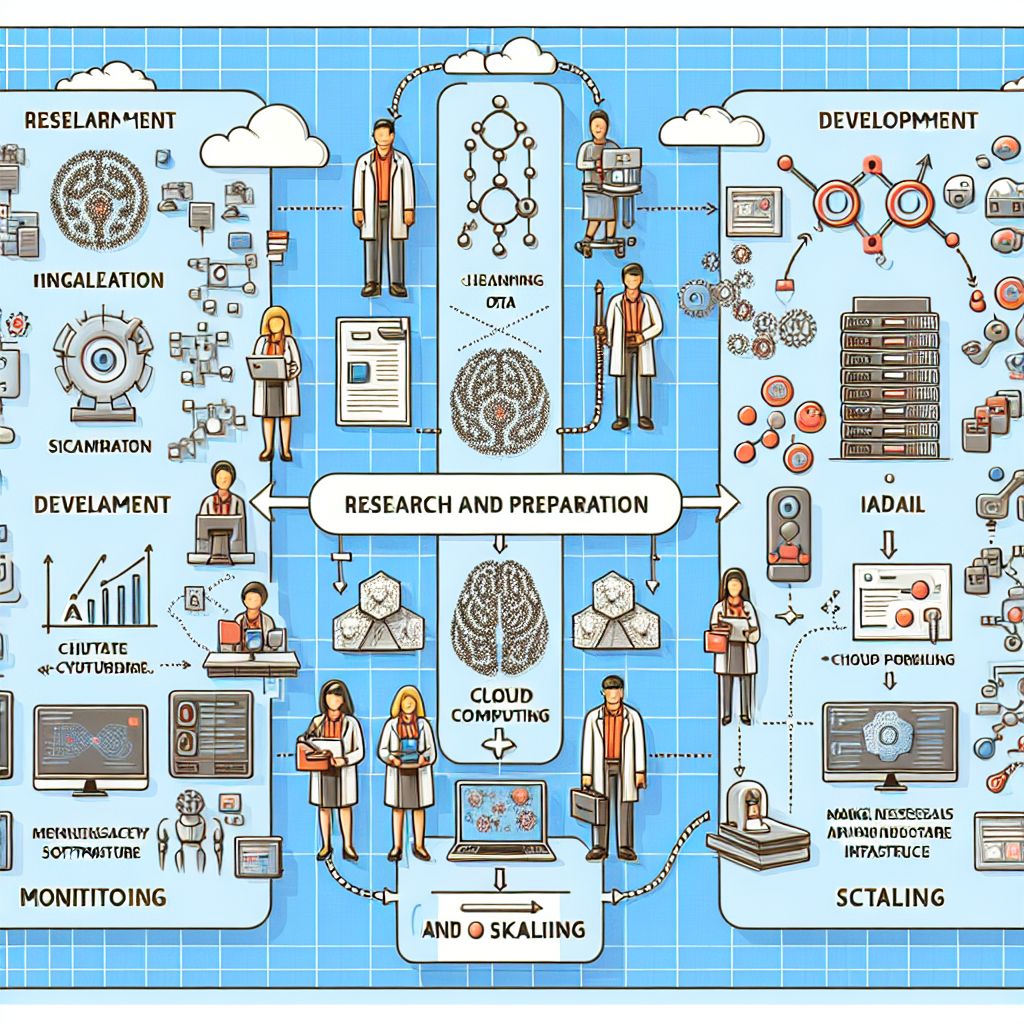In my previous articles, I've shared the three AI mindsets, strategies for content creation, market expansion, customer experience, operational excellence, ethical implementation, and ROI measurement. Today, I want to focus on how to scale successful AI initiatives across your organization.
The Scaling Challenge

Many organizations successfully implement AI in isolated pockets but struggle to scale these successes across the enterprise. According to research, while 80% of companies have implemented at least one AI pilot, only 20% have successfully scaled AI beyond the pilot stage.
Let's explore a systematic approach to scaling AI that avoids common pitfalls and maximizes your return on investment.
The 5 Phases of AI Scaling
Phase 1: Pilot Success Validation
Before scaling any AI initiative, thoroughly validate its success:
- Comprehensive Evaluation: Assess results across all five ROI dimensions (financial, operational, customer, strategic, and organizational)
- Root Cause Analysis: Identify specifically why the pilot succeeded
- Dependency Mapping: Determine what conditions, resources, or capabilities were essential to success
- Scalability Assessment: Evaluate whether the success factors can be replicated in other contexts
- Risk Identification: Pinpoint potential challenges that might emerge at scale
Implementation Strategy: Create a structured pilot validation framework that goes beyond simple metrics to understand the underlying drivers of success. Document not just what worked, but why it worked and under what conditions.
Phase 2: Scaling Readiness Assessment
Evaluate your organization's readiness to scale the AI initiative:

- Technical Infrastructure: Assess whether your systems can support expanded AI implementation
- Data Availability: Confirm that necessary data exists and is accessible across target areas
- Skill Distribution: Determine if required skills are available in areas targeted for scaling
- Process Compatibility: Evaluate whether current processes can accommodate the AI solution
- Cultural Readiness: Gauge receptiveness to AI adoption in target departments or functions
Implementation Strategy: Develop a readiness scorecard for each dimension and each target area. Identify gaps that need to be addressed before scaling and create specific action plans to build readiness.
Phase 3: Scaling Strategy Development
Create a comprehensive plan for scaling your AI initiative:

- Prioritization Framework: Determine which areas to target first based on readiness and potential value
- Adaptation Guidelines: Define how the AI solution may need to be modified for different contexts
- Resource Requirements: Identify the people, technology, and funding needed for scaling
- Timeline and Milestones: Establish a realistic schedule with clear progress markers
- Governance Model: Define decision-making processes and responsibilities for the scaling effort
Implementation Strategy: Take a portfolio approach to scaling, balancing quick wins with more complex but higher-value opportunities. Create a visual scaling roadmap that communicates the plan to all stakeholders.
Phase 4: Systematic Implementation
Execute your scaling plan with discipline and flexibility:

- Wave-Based Rollout: Implement in planned waves rather than all at once
- Knowledge Transfer: Systematically share insights and expertise from the pilot team
- Capability Building: Develop necessary skills in each area before implementation
- Adaptation Management: Make thoughtful adjustments based on different contexts
- Progress Tracking: Monitor implementation against your plan and milestones
Implementation Strategy: Create a scaling playbook that documents the step-by-step process for implementing the AI solution in new areas. Include templates, training materials, and troubleshooting guides.
Phase 5: Institutionalization
Embed the AI solution into your organization's standard operations:

- Process Integration: Fully incorporate AI into regular business processes
- Performance Management: Include AI utilization and outcomes in performance metrics
- Continuous Improvement: Establish mechanisms for ongoing enhancement
- Knowledge Management: Capture and share learnings across the organization
- Cultural Reinforcement: Celebrate and reward successful adoption and results
Implementation Strategy: Develop a transition plan for moving from "project" to "business as usual" status. Create clear ownership and accountability for the ongoing management and optimization of the AI solution.
Real-World Example: Retail Chain Transformation
Let me share how one of my clients, a mid-sized retail chain, successfully scaled an AI initiative across their organization:
The Initial Pilot:
They implemented an AI inventory optimization system in three stores that reduced stockouts by 32% while decreasing inventory costs by 18%.
The Scaling Journey:
1. Pilot Validation: They conducted a thorough analysis to understand exactly why the pilot succeeded. They discovered that success depended on three key factors: data quality from point-of-sale systems, store manager buy-in, and integration with their ordering process.
2. Readiness Assessment: They evaluated all 120 stores against these success factors and found significant variations in readiness. They categorized stores into three tiers based on readiness and potential value.
3. Scaling Strategy: They developed a three-wave implementation plan, starting with the most ready stores (Tier 1), then addressing specific readiness gaps before moving to Tier 2 and Tier 3 stores. They created a central scaling team that included members from the original pilot.
4. Systematic Implementation: The plan was executed over nine months, with each wave incorporating learnings from previous implementations. They created a standardized onboarding process that included data preparation, system configuration, and staff training.
5. Institutionalization: They updated their standard operating procedures to incorporate the AI system, revised performance metrics for store managers to include AI utilization, and established an AI Center of Excellence to support ongoing optimization.
The Results:
- Successfully scaled to all 120 stores within 12 months
- Achieved 28% reduction in stockouts across the chain
- Reduced inventory costs by 22% company-wide
- Generated $14.2 million in additional annual profit
- Created a reusable scaling methodology for future AI initiatives
The key insight was that successful scaling required as much attention to organizational and human factors as to the technical solution itself.
The 7 Critical Success Factors for AI Scaling
Based on my work with dozens of organizations, I've identified seven factors that consistently differentiate successful AI scaling efforts:
1. Executive Sponsorship and Alignment
Successful scaling requires active support from senior leadership:
- Visible commitment from executives to the scaling initiative
- Clear alignment between AI scaling and strategic priorities
- Willingness to remove organizational barriers and resolve conflicts
- Appropriate resource allocation and protection
- Regular executive review and engagement
Implementation Tip: Create an executive steering committee for your scaling initiative with regular touchpoints and clear expectations for their involvement.
2. Dedicated Scaling Team
A specialized team focused on scaling accelerates success:
- Cross-functional representation from technical and business areas
- Inclusion of members from the original pilot team
- Clear mandate and authority to drive implementation
- Appropriate skills in change management and knowledge transfer
- Full-time dedication to the scaling effort
Implementation Tip: Structure your scaling team with both a core team (full-time) and an extended team (part-time subject matter experts) to balance focus with broad expertise.
3. Standardization with Flexibility
Successful scaling balances consistency with adaptation:
- Standardized core components and methodologies
- Clear guidelines for what can and cannot be modified
- Documented adaptation process for different contexts
- Centralized learning and best practice sharing
- Continuous refinement of standards based on implementation experience
Implementation Tip: Create a "minimum viable standardization" approach that defines the essential elements that must remain consistent while allowing for contextual adaptation of non-core elements.
4. Robust Change Management
Effective change management is critical for adoption at scale:
- Compelling change story tailored to each stakeholder group
- Early involvement of key influencers in each implementation area
- Comprehensive training and support during transition
- Visible quick wins to build momentum and credibility
- Recognition and celebration of adoption and results
Implementation Tip: Identify and engage informal leaders and influencers in each area before implementation begins. Their support can be more valuable than formal authority in driving adoption.
5. Technical Infrastructure and Data Readiness
Scaling requires appropriate technical foundations:
- Scalable architecture that can support enterprise-wide deployment
- Standardized data models and integration approaches
- Clear data quality requirements and improvement processes
- Sufficient computing resources and technical support
- Security and compliance considerations addressed at scale
Implementation Tip: Conduct a technical readiness assessment early in your scaling planning to identify infrastructure investments needed to support enterprise-wide implementation.
6. Skills and Capability Building
Successful scaling requires developing capabilities across the organization:
- Tiered training programs for different roles and involvement levels
- Just-in-time skill development aligned with implementation timing
- Peer learning and knowledge sharing mechanisms
- Capability building integrated into the implementation process
- Long-term skill development pathways for key roles
Implementation Tip: Create a capability-building roadmap that aligns with your implementation waves, ensuring people develop skills just before they need to apply them.
7. Measurement and Continuous Improvement
Ongoing measurement drives successful scaling and optimization:
- Consistent metrics across all implementation areas
- Regular review of results and implementation quality
- Systematic capture and sharing of learnings and best practices
- Continuous refinement of the solution and scaling approach
- Celebration of successes and transparent addressing of challenges
Implementation Tip: Implement a simple "learn and adjust" process after each implementation wave, with structured debriefs and explicit updates to your scaling approach.
Your Next Steps
Here's how to begin scaling your AI successes:

1. Select Your Scaling Candidate: Identify one successful AI pilot that has potential for broader impact across your organization.
2. Validate Pilot Success: Conduct a thorough analysis of why the pilot succeeded and what conditions were essential to that success.
3. Assess Scaling Readiness: Evaluate potential scaling targets against the critical success factors and identify readiness gaps.
4. Develop Your Scaling Strategy: Create a phased approach to scaling with clear prioritization, resource requirements, and timeline.
5. Form Your Scaling Team: Assemble a dedicated team with the right mix of technical, business, and change management expertise.
In my next article, I'll share strategies for future-proofing your AI approach in a rapidly evolving landscape. Until then, I challenge you to select one successful AI initiative in your organization and conduct a scaling readiness assessment.
Remember, the organizations that create the most value from AI aren't those with the most pilotsâ€- they're those that can effectively scale successful initiatives across the enterprise.
Roman Bodnarchuk is the founder of 10XAI News and creator of The 10X AI Accelerator program, helping entrepreneurs leverage artificial intelligence to achieve exponential growth in their businesses. Follow him on X @10XAINews and Instagram @10XANews.
